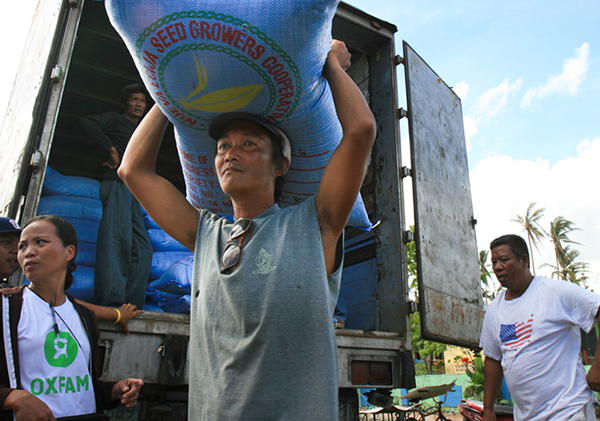NEWSLETTER
|
A Call for Reforms After Philippines Typhoon By Raymond C. Offenheiser
This article detailing Oxfam America’s recovery efforts after the typhoon that devastated the Philippines in November was prepared for the newsletter by Raymond C. Offenheiser, Oxfam’s president and a former Ford Foundation staff member in Bangladesh and Peru.
The destruction in the wake of Typhoon Haiyan is almost indescribable. Entire communities have been flattened, reduced to piles of debris, and many of those who lived through the storm are now struggling to meet their basic needs.
Haiyan took out bridges, clogged roads and paralyzed seaports and airports, leaving more than 5,000 Filipinos dead, more than 4 million homeless and millions without the means to support their families. As of the first of the year, Oxfam had reached more than 300,000 people with aid. Beyond short-term programs to ensure access to food, clean water and healthy sanitation, Oxfam is helping people restore their livelihoods and advocating for a reformed global humanitarian response system, one better suited to Twenty-first Century challenges.
With sanitation facilities destroyed and water supplies contaminated, Haiyan survivors remain at risk of contracting such deadly waterborne diseases as cholera, so providing clean water, sanitation facilities and hygiene supplies remains Oxfam’s top priority.
In the devastated city of Tacloban, Oxfam and partners worked with local authorities to restore water supplies to 80 percent of the population within a week of the storm. For many of those who still lack access to the system, we have installed 5,000-liter bladder tanks to store and distribute clean drinking water. In addition, we have airlifted supplies to the island of Cebu and distributed blankets, water purification kits and hygiene materials to thousands of families in hard-hit areas of Cebu, Leyte and Eastern Samar.
To meet urgent needs for improved sanitation in areas where displaced people have taken refuge, Oxfam and community members have joined forces to dig latrines, empty septic tanks and construct bathing facilities.
Beyond short-term programs, Oxfam is helping people restore their livelihoods. The average household income in Eastern Visayas, which includes the hard-hit areas of Samar and Leyte, is about $3,400 a year. Many people are small-scale farmers or fishermen, or earn their livings from low-paying jobs and microenterprises in the towns and cities. Since 1987, Oxfam has worked with local partner organizations in the Philippines to address poverty. When Haiyan dragged its fury across some of the nation’s poorest provinces, we knew that many of those communities would need to rebuild.
Fishing and farming families who lived in the path of the typhoon lost boats, nets, seeds and tools—the essentials they need to produce food and earn incomes—and agricultural land was badly damaged by the storm.
Oxfam and partners have launched programs that are helping tens of thousands of people feed their families, sometimes in exchange for accomplishing critical community tasks like building latrines, clearing farmland and cleaning irrigation channels of wreckage left behind by the storm. One of our highest priorities was enabling farmers to sow rice during the December planting season.
The stricken communities need thriving markets where those who need food and other essentials can buy them from local producers and traders. In the coming weeks and months, Oxfam will look for opportunities to help local markets make a swift and sustainable recovery.
In the long-term, Oxfam will continue to focus on building women’s capacity as economic leaders, advocating for change at the government level and building resilience to climate and other shocks.
Ranked the world’s third-highest disaster-risk country according to the United Nations Office for the Coordination of Humanitarian Affairs, the Philippines will continue to face multiple and possibly simultaneously occurring emergencies because of its high rate of poverty and its exposure to natural hazards.
According to the UN, the government of the Philippines has some of the strongest laws on the books aimed at reducing the risks of disaster. But good policy means very little without execution. As Haiyan revealed, the government must do a better job of investing needed resources to ensure that local authorities, those on the front lines at times of emergency, are prepared for disasters.
In an opinion article published by MSNBC in early December, I called for greater investments in civil society and governments to prepare for, respond to and avert disasters. In extreme cases, people affected by disasters will always need international assistance to help with essentials, such as shelter and clean water. Such aid has saved countless lives and must continue to do so.
But the answer is not bigger international relief organizations. It is not airdropping more supplies onto island nations. Nor is it swarming in with solutions, shouldering aside local citizens groups, discounting local knowledge and treating whole nations like helpless children.
During the coming decade, catastrophes like Typhoon Haiyan will cause billions of dollars in damage in poor countries, kill many thousands of people and require at least $1 trillion in public humanitarian aid.
In most places, in most cases, governments and citizens in affected countries can develop workable strategies to deal with emergencies. The role of outside aid groups such as Oxfam and multi-lateral institutions should be to invest in vulnerable countries so that local and national institutions have the resources and expertise in place to safeguard their people.
The global community must have the commitment and foresight to make these investments early—before disaster strikes.
|


